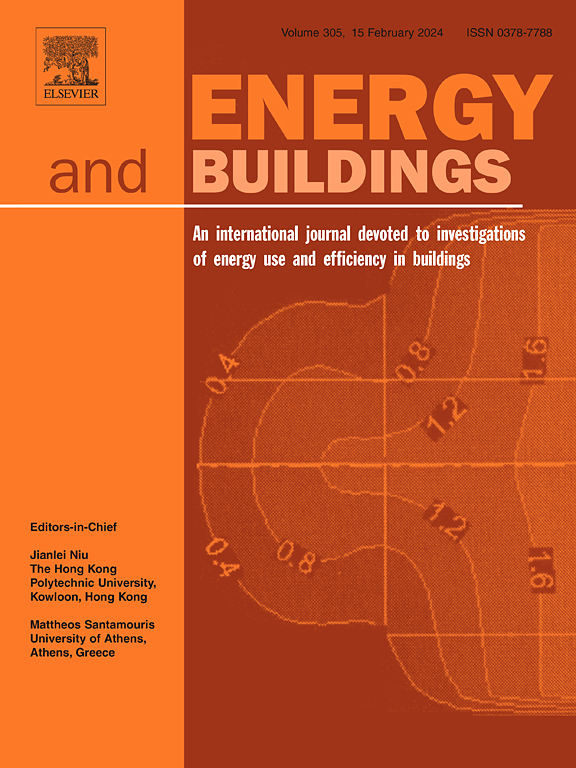考虑能耗和发电量优化动能光伏遮阳设备的倾斜角度--香港案例
IF 6.6
2区 工程技术
Q1 CONSTRUCTION & BUILDING TECHNOLOGY
引用次数: 0
摘要
光伏遮阳设备(PVSD)是光伏建筑一体化(BIPV)的重要组成部分,既能实现建筑遮阳功能,又能为建筑物提供现场可再生能源。以往的研究主要关注单层或低层建筑中光伏聚光装置的能源效率,往往忽视了多层建筑中上层装置对下层装置遮阳所产生的热热点效应,这严重影响了光伏系统的效率和使用寿命。本研究以香港的一栋高层住宅为研究对象,在设计动能式 PVSD 的同时,还采用了三种创新控制策略,旨在最大限度地降低能耗,优化光伏效率。研究结果表明,在香港的情况下,光伏板宽度与相邻 PVSD 垂直间距的比例低于 1:10,可防止设备之间的垂直遮挡。此外,与不安装 PVSD 的机组相比,将 PVSD 全年固定在 65° 的最佳角度、调整到每月最佳角度或采用实时角度优化,可分别减少 25%、31.9% 和 36.5%的能耗。此外,每小时控制策略比每月和每年控制策略多发电 6.4% 和 11.4%。本研究讨论的动能光伏太阳能装置(PVSD)和不同的控制策略为在人口稠密的城市外墙集成光伏建筑一体化(BIPV)提供了宝贵的实践启示。这些研究结果也为在高密度环境中推进零碳建筑实践提供了支持。本文章由计算机程序翻译,如有差异,请以英文原文为准。
Optimizing the tilt angle of kinetic photovoltaic shading devices considering energy consumption and power Generation— Hong Kong case
Photovoltaic Shading Devices (PVSDs) serve as integral components of Building-Integrated Photovoltaics (BIPV), fulfilling both architectural shading functions and supplying on-site renewable energy to buildings. Previous studies have primarily focused on the energy efficiency of PVSDs in single-story or low-rise buildings, often overlooking the thermal hotspot effects caused by the shading of upper devices on lower ones in multi-story settings, which significantly impairs the efficiency and lifespan of the PV systems. This study focuses on a residential high-rise in Hong Kong, where a kinetic PVSD was designed alongside three innovative control strategies aimed at minimizing energy consumption and optimizing photovoltaic efficiency. Results indicate that in Hong Kong’s context, a ratio of PV panel width to the vertical spacing of adjacent PVSDs below 1:10 prevents vertical shading between devices. Moreover, setting the PVSDs at a constant optimal angle of 65° throughout the year, adjusting to optimal monthly angles, or employing real-time angle optimization can reduce energy consumption by 25%, 31.9%, and 36.5%, respectively, compared to units without PVSDs. Furthermore, the hourly control strategy generated 6.4% and 11.4% more electricity than the monthly and yearly control strategies. The kinetic photovoltaic solar devices (PVSD) and the diverse control strategies discussed in this research provide valuable practical insights for the integration of building-integrated photovoltaics (BIPV) on urban facades in densely populated cities. These findings also support the advancement of zero-carbon building practices in high-density environments.
求助全文
通过发布文献求助,成功后即可免费获取论文全文。
去求助
来源期刊

Energy and Buildings
工程技术-工程:土木
CiteScore
12.70
自引率
11.90%
发文量
863
审稿时长
38 days
期刊介绍:
An international journal devoted to investigations of energy use and efficiency in buildings
Energy and Buildings is an international journal publishing articles with explicit links to energy use in buildings. The aim is to present new research results, and new proven practice aimed at reducing the energy needs of a building and improving indoor environment quality.
 求助内容:
求助内容: 应助结果提醒方式:
应助结果提醒方式:


